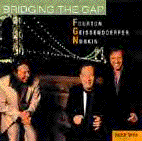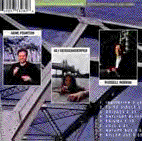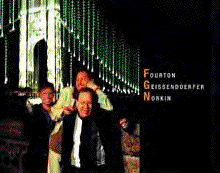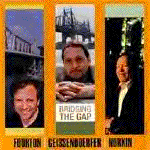TEMPORARY TEST SITE / UNDER CONSTRUCTION
BRIDGING THE GAP
A U D I O
|
  |
A U D I O
|
With a fresh, fiery take on the organ trio format, drummer Gene Fourton, Hammond B-3 organ player Uli Geissendoerfer and guitarist Russell Norkin have pushed the envelope on their first outing together, Bridging The Gap. Inspired by the heightened vibe of the Tony Williams Lifetime band from the late '60s - early '70s, these three seasoned New York musicians attack the music with youthful enthusiasm and abandon on this exhilarating session. The brainchild of drummer Fourton, who studied with the likes of Steve Jordan, Elvin Jones, Joe Morello and the aforementioned Williams, along with being a graduate of Columbia University who majored in musicology, this triumvirate strikes a bold accord on four well-chosen standards and four originals by principal composer Norkin, a 1970's graduate of the Berklee College of Music and a high school pal of Fourton's. And for Fourton, a longtime professional with a wealth of road experience as well as innumerable credits on Broadway, television and the New York jingle scene, Bridging The Gap marks the very first recording project that he initiated. "It's the first time I've ever gotten around to doing my own thing," says Fourton, who toured and performed with the Lionel Hampton Orchestra in the late '70s as well as having worked with the likes of Stan Getz, Esther Phillips, Bob Fosse, Arthur Fiedler, and "Wild" Bill Davis and the Boston Pops Symphony Orchestra. "After all this time I finally just said, "I gotta do it!" Sparked by Geissendoerfer's dazzling keyboard, producing and arranging skills and Norkin's warm-toned, Grant Green-inspired guitar work, Fourton is doing it with a sense of urgency and joie de swing on the trio's maiden voyage together.
|
 |
Just as Larry Young's modernist take on the B-3 helped define the forward-looking thrust of Lifetime, so does Geissendoerfer's unique approach to the instrument he affectionately refers to as "The Beast" underscore this trio's probing yet groove-conscious nature. A native of Munich, Uli's earliest memories of the Hammond B-3 organ go back to '60s rock bands like Emerson, Lake & Palmer, Procol Harum, Deep Purple and the Allman Brothers. During that formative period in his career in Germany, he was a drummer in a string of Southern rock and r&b bands,
occasionally also playing harmonica. Since moving to America in 1987, Geissendoerfer has delved into a variety of musical settings, including gospel, jazz, classical and a spate of Latin gigs over the years. Interestingly enough, Geissendoerfer went to school in Munich with
|
Germany's renowned mistress of the B-3, Barbara Dennerlein. "She was one year ahead of me," he recalls. "At the time I didn't even play jazz. I was more into rock and funk. The B-3 for me is a somewhat new instrument. I'm still woodshedding on it. This is my first real outing on record as a B-3 player and I'm totally loving this instrument. What I love about the organ is that the sound is so thick. You can play one note and let it swell and hang there. You're more like a horn player with this instrument. Plus, it's got a totally percussive edge to it so you can treat it as a percussion instrument as well."
They come out of the gate adrenalized on a blazing rendition of "Invitation" with Fourton's brisk ride cymbal work and Geissendoerfer's surging basslines setting the urgent tone. On Norkin's Third Circle they maintain that spirited, swinging momentum through some intriguing rhythmic and harmonic development. As the composer explains, "The title of that tune comes from my study of martial arts. When I got with the instructor he explained that in any confrontation there are three circles -- a first circle where you're wondering what will happen, a second circle where it's pretty obvious someone's going to attack you, and when it penetrates the third circle, so to speak, you have to be ready to fight." The analogy here is that the tune starts off gently, progresses to a more aggressive section and gets positively frantic by the solo section.
|
 |
Norkin's involved title track is another that travels through a myriad of moods and motifs. As he explains, "I wanted to try a format where I would write an extended composition with all kinds of sections and meter changes. I've been influenced by jazz and modern classical composers in my writing and I try to incorporate that in my tunes." Indeed, there is one section where the harmony is reminiscent of Debussy while another meter-changing section might be something akin to Bartok or Stravinsky. And that leads right into the 4/4 blowing section in which Uli and Russell get to flex their jazz muscles.
"Daylight Blues" is Norkin's swinging mid-tempo minor blues that again allows for some serious stretching by the guitarist. "That title comes from the fact that I had problems sleeping after attempting to decompress from certain music gigs," he explains, "So by 9 a.m. on one particular morning when I couldn't go to sleep, I was playing my guitar and managed to write that tune." Uli also solos heroically here.
Norkin's "Enigma" opens with a brief taste of lush solo guitar before dissolving to another fleet-fingered romp underscored by Fourton's Brazilian samba feel. "It's a nine-bar song," offers the composer, "and that's pretty enigmatic to me. Hence, the title."
The trio's energized rendition of Wayne Shorter's "Juju" teeters into the free zone in the middle section. Russell digs in here while Uli wails with a searing edge, spinning uncliched lines that, while not based in a grits 'n' gravy blues bag of B-3 professors Jack McDuff or Jimmy McGriff, deftly combine progressive jazz and rock motifs in a sort of Rick Wakeman-meets-Larry Young style. Fourton also unleashes with some whirlwind activity on the kit during his solo.
|
 |
A mysterioso take on "Nature Boy," taken at a relaxed, easy tempo, is grounded by Uli's deep-toned walking basslines while the melody is carried alternately by organist and guitarist, who pass it back and forth like twin point guards on a championship basketball team.
|
Uli swells chords and walks basslines behind Russell, who then arpeggiates hypnotically behind Uli. Russell's blues-drenched, deliberate approach to his solo here is particularly reminiscent of Grant Green while Uli takes his time in crafting his most expressive statement on the collection.
They close with the quintessential toe-tapping jam vehicle "Killer Joe," done with suitably bluesy sentiments from Norkin and sparked by some modernistic splashes from Geissendoerfer, who (literally) pulls out all the stops on this extroverted finale.
With one foot placed firmly in the jazz camp and another striding down an adventurous fusion path, Fourton, Geissendoerfer & Norkin are most definitely Bridging The Gap on this auspicious debut. -- Bill Milkowski
Bill Milkowski is a regular contributor to Jazz Times and Jazziz magazines. He is also the author of "JACO: The Extraordinary And Tragic Life of Jaco Pastorius" (Backbeat Books)
|
2014 Mark D. McKinley